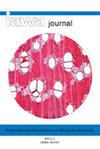Wood structural diversity in fynbos, chaparral, and maquis: a preliminary estimation
IF 3.5
3区 农林科学
Q2 FORESTRY
引用次数: 0
Abstract
Fynbos, a shrubland from the Cape Floristic Region in South Africa, is one of five Mediterranean-climate biomes alongside maquis in the Mediterranean Basin, chaparral in California, matorral in Central Chile and kwongan in Southwestern Australia. We compiled the available information on the wood anatomy of 226 species belonging to 65 genera of 14 families that occurred in fynbos and compared this dataset with the published data on wood diversity in Californian chaparral and Israeli maquis. “Carlquist’s Law”, i.e., the association between the ground tissue made of fibre tracheids and low vessel grouping, has been confirmed for the fynbos plants. The lack of ring porosity and very low incidence of semi-ring-porous woods is the most prominent difference of the fynbos from the other two vegetation types. These features are attributed to the paucity of deciduous plants in fynbos which is probably associated with the poor-nutrient soils in this biome. The fynbos differs from chaparral and maquis also in the greatest percentage of the species having no tracheids in their wood as well as with the lowest incidence of helical thickenings on the vessel walls. These differences could be explained by the lower tolerance of fynbos shrubs to seasonal drought due to the relatively mild dry season in this biome. We also found that some differences between fynbos, chaparral, and maquis in the incidences of fibre tracheids and vasicentric/vascular tracheids associated with large vessel groups can be at least partly explained by different systematic compositions of their floras. The higher percentage of distinct growth rings, greater vessel diameter, and lower vessel frequency in maquis compared with fynbos and chaparral can be attributed to a common occurrence of relatively tall trees in this vegetation.森林、矮林和灌木丛中的木材结构多样性:初步估算
Fynbos是来自南非开普植物区(Cape Floristic Region)的灌木丛,与地中海盆地的maquis、加利福尼亚的chaparral、智利中部的matorral和澳大利亚西南部的kwongan一起,是五个地中海气候生物群落之一。本研究收集了fynbos地区14科65属226个树种的木材解剖资料,并与已发表的加利福尼亚灌木林和以色列马奎斯树种的木材多样性数据进行了比较。“卡尔奎斯特定律”,即由纤维管胞组成的地面组织与低血管组之间的联系,已被证实适用于fynbos植物。与其他两种植被类型相比,环孔率低、半环孔率低是其最显著的差异。这些特征是由于该地区落叶植物的缺乏,这可能与该生物群系的土壤养分不足有关。在木材中没有管胞的物种所占的比例最大,而在血管壁上螺旋增厚的发生率最低,这一点也与灌木林和猕猴不同。这些差异可能是由于该生物群系相对温和的旱季导致飞狐灌木对季节性干旱的耐受性较低。我们还发现,在与大血管群相关的纤维管状体和血管中心管状体的发生率上,丰丰林、灌木林和马基林之间存在一些差异,这至少可以部分地解释为它们的植物区系组成不同。与林荫灌木和林荫灌木相比,马丘比丘的不同年轮比例更高,导管直径更大,导管频率更低,这可能是由于马丘比丘植被中普遍存在相对较高的树木。
本文章由计算机程序翻译,如有差异,请以英文原文为准。
求助全文
约1分钟内获得全文
求助全文
来源期刊

IAWA Journal
农林科学-林学
CiteScore
3.40
自引率
15.80%
发文量
26
审稿时长
>36 weeks
期刊介绍:
The IAWA Journal is the only international periodical fully devoted to structure, function, identification and utilisation of wood and bark in trees, shrubs, lianas, palms, bamboo and herbs. Many papers are of a multidisciplinary nature, linking
 求助内容:
求助内容: 应助结果提醒方式:
应助结果提醒方式:


